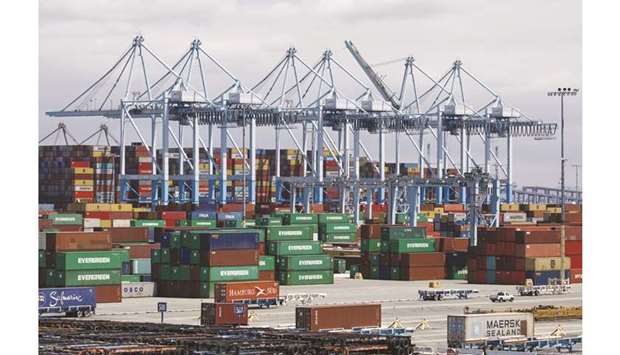US and Chinese trade officials are “close to finalising” some parts of an agreement after high-level telephone discussions yesterday, the US Trade Representative’s office said, adding that deputy-level talks would proceed “continuously.”
In a statement issued after the call, the USTR provided no details on the areas of progress.
“They made headway on specific issues and the two sides are close to finalising some sections of the agreement.
Discussions will go on continuously at the deputy level, and the principals will have another call in the near future,” it said.
The call came as Washington and Beijing are working to agree on the text for a “Phase 1” trade agreement announced by US President Donald Trump on October 11.
Trump has said he hopes to sign the deal with China’s President Xi Jinping next month at a summit in Chile.
Beijing was expected to request cancellation of some planned and existing US tariffs on Chinese imports during the phone call, people briefed on the negotiations told Reuters.
In return, China was expected to pledge to step up its purchases of US agricultural products.
The world’s two largest economies are trying to calm a nearly 16-month trade war that is roiling financial markets, disrupting supply chains and slowing global economic growth.
“They want to make a deal very badly,” Trump told reporters at the White House.”They’re going to be buying much more farm products than anybody thought possible.”
So far, Trump has agreed only to cancel an October 15 increase in tariffs on $250bn in Chinese goods as part of understandings reached on agricultural purchases, increased access to China’s financial services markets, improved protections for intellectual property rights and a currency pact.
But to seal the deal, Beijing is expected to ask Washington to drop its plan to impose tariffs on $156bn worth of Chinese goods, including cell phones, laptop computers and toys, on December 15, two US-based sources told Reuters.
Beijing also is likely to seek removal of 15% tariffs imposed on September 1 on about $125bn of Chinese goods, one of the sources said.
Trump imposed the tariffs in August after a failed round of talks, effectively setting up punitive duties on nearly all of the $550bn in US imports from China.
“The Chinese want to get back to tariffs on just the original $250bn in goods,” the source said.
Derek Scissors, a resident scholar and China expert at the American Enterprise Institute in Washington, said the original goal of the early October talks was to finalise a text on intellectual property, agriculture and market access to pave the way for a postponement of the December 15 tariffs.
“It’s odd that (the president) was so upbeat with (Chinese Vice-Premier) Liu He and yet we still don’t have the December 15 tariffs taken off the table,” Scissors said.
US Treasury Secretary Steven Mnuchin last week said no decisions were made about the December 15 tariffs, but added: “We’ll address that as we continue to have conversations.”
If a text can be sealed, Beijing in return would exempt some US agricultural products from tariffs, including soybeans, wheat and corn, a China-based source told Reuters.
Buyers would be exempt from extra tariffs for future buying and get returns for tariffs they already paid in previous purchases of the products on the list.
But the ultimate amounts of China’s purchases are uncertain.
Trump has touted purchases of $40bn to $50bn annually — far above China’s 2017 purchases of $19.5bn as measured by the American Farm Bureau.
One of the sources briefed on the talks said China’s offer would start at around $20bn in annual purchases, largely restoring the pre-trade-war status quo, but this could rise over time.
Purchases also would depend on market conditions and pricing.
US Trade Representative Robert Lighthizer has emphasised China’s agreement to remove some restrictions on US genetically modified crops and other food safety barriers, which the sources said is significant because it could pave the way for much higher US farm exports to China.
The high-level call came a day after US Vice President Mike Pence railed against China’s trade practices and what he termed construction of a “surveillance state” in a major policy speech.
But Pence left the door open to a trade deal with China, saying Trump wanted a “constructive” relationship with Beijing.
While the US tariffs on Chinese goods has brought China to the negotiating table to address US grievances over its trade practices and intellectual property practices, they have so far failed to lead to significant change in China’s state-led economic model.
The “Phase 1” deal will ease tensions and provide some market stability, but is expected to do little to deal with core US complaints about Chinese theft and forced transfer of American intellectual property and technology.
The intellectual property rights chapter in the agreement largely deals with copyright and trademark issues and pledges to curb technology transfers that Beijing has already put into a new investment law, people familiar with the discussions said.
More difficult issues, including data restrictions, China’s cybersecurity regulations and industrial subsidies will be left for later phases of talks.
But some China trade experts said that a completion of a Phase 1 deal could leave little incentive for China to negotiate further, especially with a US election in 2020.
“US-China talks change very quickly from hot to cold but, the longer it takes to nail down the easy phase 1, the harder it is to imagine a phase 2 breakthrough,” said Scissors. Pages 2, 3 & 12
US, China ‘close to finalising’ parts of trade pact Phase 1

Related tags :


